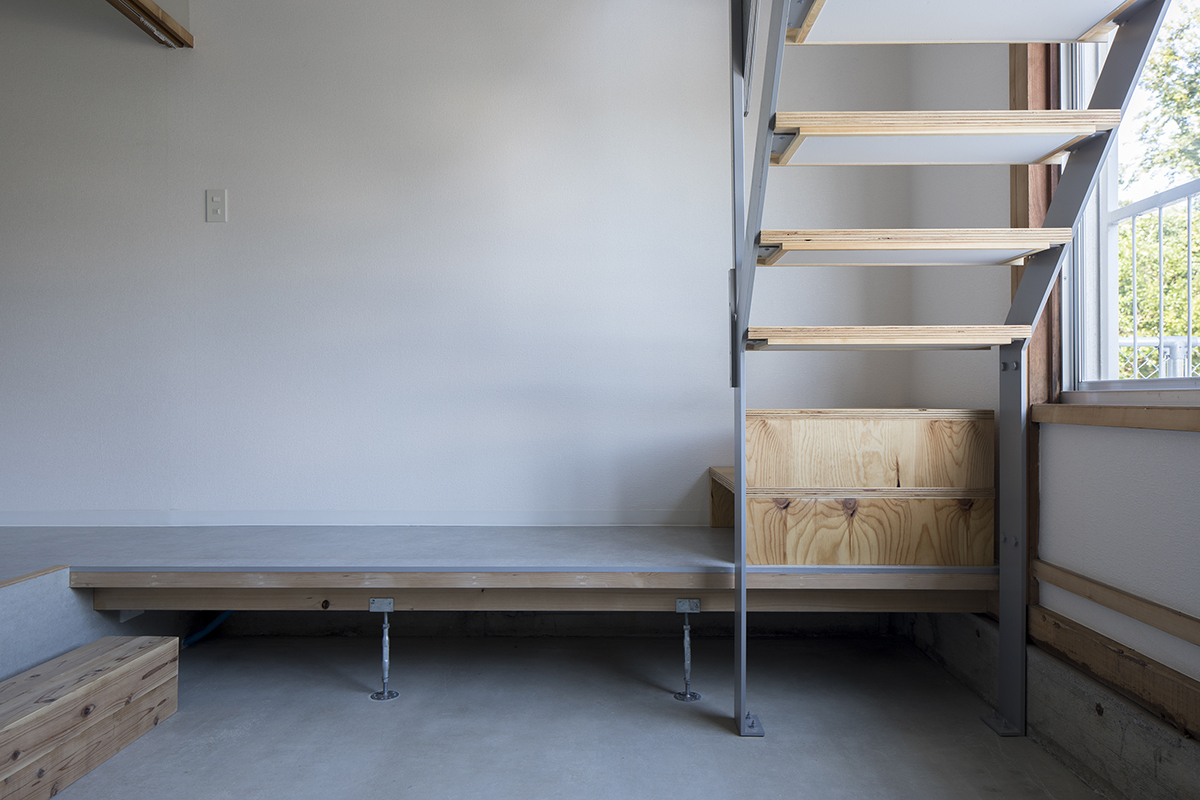ハイツH
所在地:東京都八王子市
敷地面積:690.48㎡
延床面積:396.614㎡(建築面積:262.82㎡)
構造/規模:木造/地上2階建
最高高さ/軒高:7.0m/6.3m
用途:長屋
建築:馬場兼伸+山内健太郎+徳竹美月
施工:ルーヴィス
発注元:個人
設計施工期間:2018.04‐2019.11
撮影:山岸剛
動線の操作で木賃アパートの形骸化を楽しむ
東京西部の郊外に建つ築40年ほどの木造共同住宅を改修した。ターミナル駅からバスで20分ほどの場所にあり、周辺は武蔵野の景観が残る一画で、敷地の際には小川が流れ雑木林が間近に見える。
1970年代後半に近隣への大学の移転計画を受けて学生向け需要を狙い建築されたもので、それぞれ計6坪12畳、1・2階10戸ずつ計20戸の専有部に、玄関+台所3畳、浴室2畳、押入れ1畳、寝室6畳という典型的な間取り。建物北側の外部には共用廊下に面して20台分の洗濯機置場があり、南側には植え込みが繁茂し内部の重層した生活感も相まって鬱蒼とした雰囲気に包まれていた。オーナー一家は隣地に住んでおり、建て替えか改修か費用と利回りを比較検討したとのことだが、この建物とその内外で重ねられてきた出来事への思い入れも判断を後押ししたのではないかと思う。
木造共同住宅の素朴な形式を暴力的に刷新するのでも、そこに新たなライフスタイルを掲げるのでも、間取りや内装、建具などの慣習的に反復する要素を操作して介入するのでもなく、それが日常性を保存し新たな見えを生むような改修を目指した。この建物がこれからの不確定な未来を受け入れる状態を設計しようと考えたからだ。
住戸を上下に繋ぎ,2層の専有部を持つ長屋とすることで、動線が変わり、専有/共有の境界が動く。また玄関の位置を1・2階と東西に交互に割り振りアプローチの方向を増やすことや、土間・1階・階段・荒床・2階と床レベルを増やすことで、視点が豊富になり既存の形式がわずかな差異を持って見えることを狙った。
断面的には2戸分の容積を(改修前は上階の配管懐だった天井を撤去すると階高も大きい)、平面的には東面の外構を各戸に区分、共用廊下は1戸おきに撤去して分割し専有化することで、建物と敷地の大きさや周辺環境に価値を見出そうとした。
こうして小さな確からしいことを積み重ねた結果、動線や水回り配置、外部との関係、微細な仕上げの残滓などに個性のある複数のタイプが生じた。
既存建物は当初の意義が失われ、中身のない形骸化した状態だったが、木造共同住宅(木賃アパート)であることをやめず、改修によってさらにその内外にさまざまなズレが生じている状態には、平穏と開放が入り混じる独特の快楽がある。形骸化した状態に新たな中身を構想して意味をつくるのではなく、それ自体を多様に発見的に感じるように展開し、未来に生じるかもしれない意味の可能性を豊かにしたいと考えた。
既に人によってつくられた層の上で、不確かな未来のために建築にできることは何か、引き続き考えていきたい。
To enjoy the loss of content in a wooden apartment through the manipulation of the circulation
Renovation of a 40-year-old wooden apartment in a suburb of western Tokyo. Located about a 20-minutes bus ride from a terminal station, it is surrounded by a landscape reminiscent of the old Musashino plain with a stream running by the site and a forest nearby.
The apartment was built to accommodate the students expected to increase in number due to the relocation plan of a university to a nearby site in the 1970s. The original building was composed of 20 units — 10 units on the ground floor and 10 on the second floor, each of 6 tsubo , or 12 jo (19.83 m2). The units had a standard room layout with 3-jo (4.96 m2) for the entrance+kitchen, 2 jo (3.31 m2) for the bathroom, 1 jo (1.65 m2) for the storage space, and 6 jo (9.94 m2) for the bedroom. On the outside on the north side facing the shared corridor, there was a space for 20 washing machines, while on the south side was a thick shrubbery, which, together with the layered atmosphere of everyday lives inside, created a dense air around the building. The owner family who lived next door compared the costs and returns for rebuilding and renovating, but, in the end, iit seemed that their emotional attachment to the events accumulated inside and outside the building contributed to the final decision.
What we aimed for with the renovation was not to violently change the simple style of a wooden apartment, to propose a new lifestyle, or to intervene by manipulating the repeating conventional elements such as doors or windows, but to help the architecture preserve the everydayness and to produce new appearances. We wanted to design a state for the building that can accept the uncertain future to come.
By vertically connecting the two units on the bottom and upper floor, creating a terraced house with a two-story private space per household, the circulation is transformed, and the boundary between private and shared spaces is shifted. The directions of approach are multiplied by alternatingly placing the entrances on the bottom floor, upper floor, on the east, or on the west. We also added various floor levels such as earthen floor, ground floor, staircase, naked floor and second floor. By doing so, perspectives are enriched, and the existing form appears to gain slight differences.
The volume of a new unit amounts to that of the existing 2 units in section (the floor height became more ample by removing the upper floor ceiling space which was used for piping). In plan, the east side exterior space was divided and allocated to each unit, and the shared corridor was removed at every other unit so that it became a private space for some of the units. What we tried to discover were the values in the building itself, the expanse of the site, and the surrounding environment.














